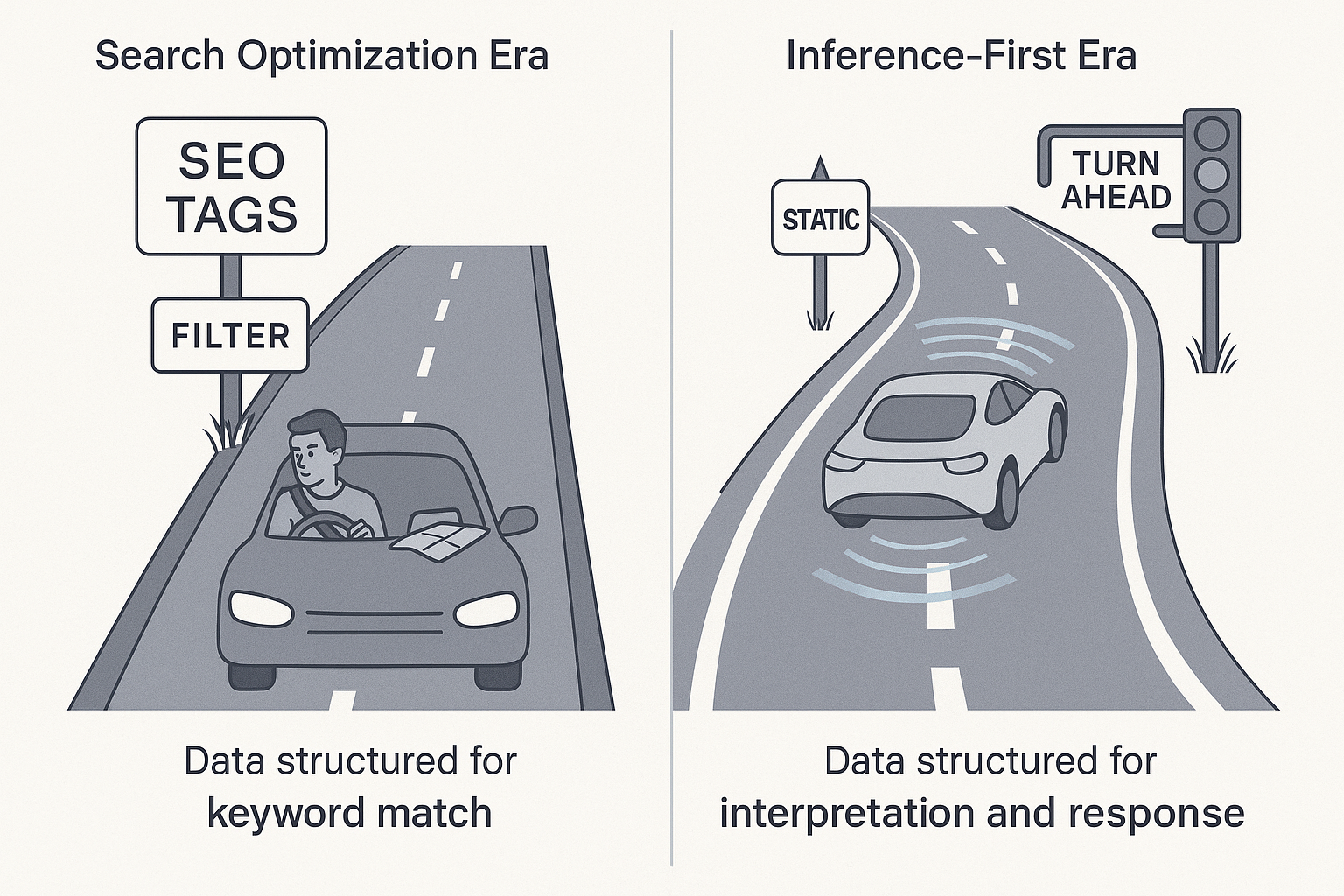You’re Sending Self-Driving Cars Down Unmarked Roads
AI doesn’t fail because it’s bad — it fails because your data lacks the infrastructure it needs to navigate. Language models don’t just search — they interpret. Most orgs haven’t built for that.

AI isn’t magic. It just needs better roads.
We keep layering AI onto legacy infrastructure like it’s plug-and-play. Like we can slap a language model on top of our data mess and call it innovation.
But it’s not magic. It’s a vehicle.
And the road you give it matters.
I. The Illusion of Readiness
Every team wants to talk about “AI integration.” Especially in e-commerce. Whether it’s product discovery, chatbot interfaces, or internal tools — the excitement is real. But here’s what I’m seeing across the board:
Teams are rolling out self-driving cars and wondering why the ride feels so rough.
And the answer is simple.
The roads weren’t built for this.
II. From Search to Semantics
Our data infrastructure — especially in e-commerce — was shaped by decades of optimizing for search. External search (Google) meant SEO hacks and keyword stuffing. Internal search meant filters, sorting rules, and exact-match queries. The structure didn’t need to be smart. Just visible.
That shaped how we stored data:
- Flat product schemas
- Siloed reviews and content
- Inconsistent metadata
- Taxonomies optimized for navigation, not meaning
And for a while, that worked.
But language models don’t operate in that world.
III. Roads, Vehicles, and the Coming Collision
Think of your data like a road network.
- Legacy product data? Roads with no markings, broken intersections, and signs designed for humans — not machines.
- Search engines? Like early GPS — read the signs, follow the coordinates.
- LLMs? Self-driving cars. Powerful, adaptive, fast — but only as good as the infrastructure underneath.
And here’s the shift:
Language models don’t just follow signs.
They interpret the terrain.
They run silent subroutines like:
- “Is this what you said?”
- “Is this what you meant?”
Let’s say a user types:
“What shoes are good for hiking somewhere muddy but not super cold?”
A traditional system fails without exact tags.
A language model tries to fill in the gaps:
- Recognize “muddy” as trail grip
- Rule out “super cold” boots
- Map to product attributes (waterproof, breathable, mid-weight)
But if your catalog is missing those connections — or worse, filled with mismatched synonyms and sparse descriptions — the system misfires.
That’s like sending a self-driving car down an unmarked road in the fog, with two contradictory signs at the next intersection.
Inference breaks.
Trust erodes.
The AI didn’t fail — the road did.
IV. Cheap Asphalt Over Broken Infrastructure
The temptation is to layer a sleek LLM wrapper over old systems. Bolt ChatGPT into your site. Spin up a Q&A bot. Mask the data debt with a pretty interface.
But here’s the problem:
Paving over a broken foundation doesn’t fix the road.
It just hides the cracks — until something breaks.
And when AI systems break, they don’t fail quietly.
They hallucinate. They route users to irrelevant products.
They generate confident nonsense.
And they do it fast.
V. What the New Roads Require
This is the moment to rebuild.
Not the whole system at once — but with intent.
Modern inference needs modern infrastructure. That means:
- Semantic clarity
Not just field labels, but meaningfully connected concepts. “Trail-ready” should point to grip, not just a tag. - Cross-domain linkage
Products, reviews, FAQs, and policies should be interwoven. Not stored in silos. - Interpretability over completeness
It’s not about having every field. It’s about making the key ones unambiguous and aligned. - Freshness and consistency
AI systems favor recent, coherent, and well-structured inputs.
Legacy sync delays and mismatches break the illusion fast.
VI. A Final Prompt
You optimized your site for Google.
You built filters for Bolt-On Search engines.
But now you’re asking a language model to understand your entire catalog.
Is your data ready for that?
Most aren’t.
The ones that get there first — not just with AI pilots but with real infrastructure beneath them — are going to win the next era of interface.
Because AI is no longer just a feature.
It’s the new terrain.
And it can only go as far as the roads we build.
🧭 Diagram: "Search vs AI — What the Road Requires"

Left Side: "Search Optimization Era"Straight roadStatic signs: SEO tags, filter checkboxesHuman driver with mapData structured for keyword matchRight Side: "Inference-First Era"Complex road with lane markings, signals, and dynamic signageSelf-driving vehicle navigating intentSensors = semantic context, structured relationshipsData structured for interpretation and response
Filed under: AI-as-Infrastructure, E-commerce Systems, Data Design


